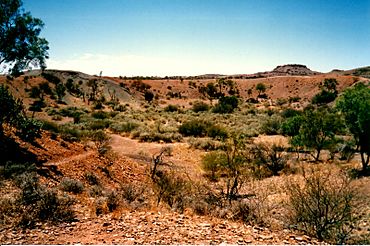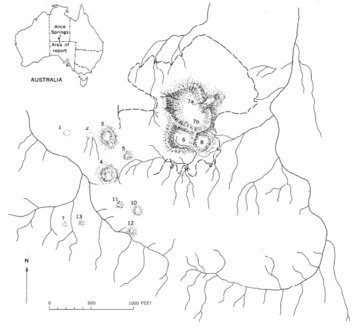Henbury Meteorites Conservation Reserve facts for kids
Quick facts for kids Henbury Meteorites Conservation ReserveGhan, Northern Territory |
|
|---|---|
|
IUCN Category III (Natural Monument)
|
|

Henbury Meteorites Conservation Reserve
|
|
| Nearest town or city | Alice Springs |
| Established | 1964 |
| Area | 16 hectares (40 acres) |
| Managing authorities | Parks and Wildlife Commission of the Northern Territory |
| See also | Protected areas of the Northern Territory |
The Henbury Meteorites Conservation Reserve is a special protected area in Australia's Northern Territory. It's famous for its amazing craters, which were formed when a meteorite crashed into Earth a long, long time ago. This place is one of the few spots on Earth where a meteorite impact happened in an area where people lived.
Contents
Discover the Henbury Craters
The Henbury Meteorites Conservation Reserve is about 125 kilometers (78 miles) southwest of Alice Springs. It holds more than a dozen craters. These craters were made when a large meteorite broke into many pieces before hitting the Earth.
Henbury is one of the best places in the world to see a small field of meteorite craters. It's also one of only five meteorite impact sites in Australia where you can still find pieces of the original meteorite. Henbury was the first place in Australia where scientists officially confirmed that craters were made by a meteorite impact.
How the Craters Formed
| Lua error in Module:Location_map at line 420: attempt to index field 'wikibase' (a nil value). | |
| Impact crater/structure | |
|---|---|
| Confidence | Confirmed |
| Diameter | 7 to 180 m (23 to 591 ft) |
| Depth | 15 m (49 ft) |
| Age | 250 Y |
| Country | Australia |
At Henbury, there are 13 to 14 craters. They range in size from 7 meters (23 feet) to 180 meters (590 feet) across. The deepest craters are up to 15 meters (49 feet) deep. These were formed when the meteorite broke apart just before it hit the ground.
Scientists have found several tons of iron and nickel fragments from the meteorite at the site. They believe the impact happened about 4,200 to 4,700 years ago.
The Discovery of Henbury Craters
The craters are named after Henbury Station, a nearby cattle farm. The farm was named in 1875 after a family home in Henbury, England. The craters were first found in 1899 by the farm's manager.
However, they weren't fully studied until 1930. This was after another meteorite, the Karoonda meteorite, fell in South Australia. The first scientific studies of the Henbury site were done by A.R. Alderman in 1932. Many more studies have happened since then.
Aboriginal Stories of the Craters
The Henbury crater field is a very important place for several Aboriginal language groups. These include the Arrernte, Luritja, Pitjantjatjarra, and Yankunytjatjara people. It is considered a sacred site by the Arrernte people. The craters likely formed when people were already living in the area.
Older Aboriginal people would not camp close to the Henbury craters. One elder explained that Aboriginal people would not drink rainwater from the craters. They feared a "fire-devil" would fill them with iron. This elder said his grandfather had seen the "fire-devil," who came from the Sun.
An Aboriginal person described the crater field in the Luritja language. It roughly means: A fiery devil ran down from the Sun and made his home in the Earth. He will burn and eat any bad blackfellows. This suggests that the memory of the impact event has been passed down through generations.
Another story tells how the largest crater was formed. It says an ancestral lizard woman, named Mulumura, tossed soil out of the crater. This created its bowl shape. The soil she threw explained the piles of meteorite iron around the craters. The Parks and Wildlife Commission of the Northern Territory calls the crater field Tatyeye Kepmwere or Tatjakapara in the Arrernte language.
Protecting the Henbury Craters
In 1980, the Henbury Meteorites Conservation Reserve was listed on the now-closed Register of the National Estate. The craters were also added to the Northern Territory Heritage Register on August 13, 2003. This helps protect this unique and important natural site for the future.




